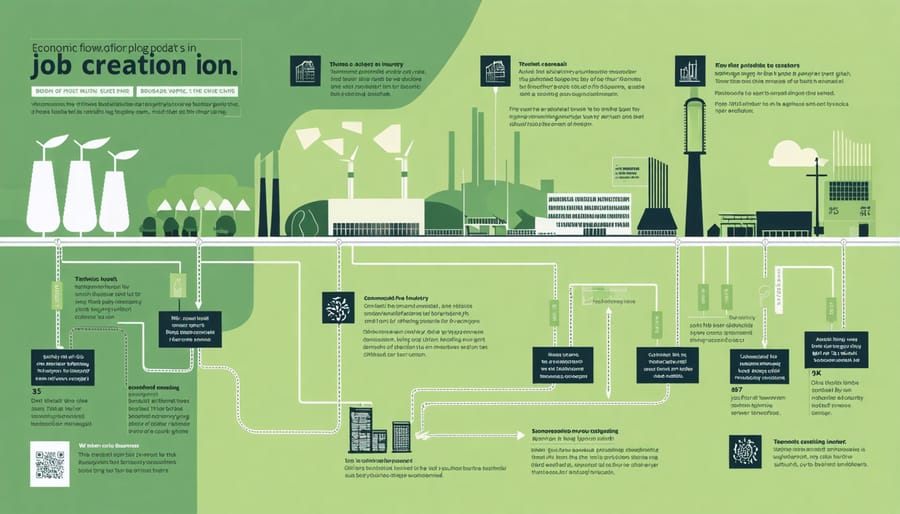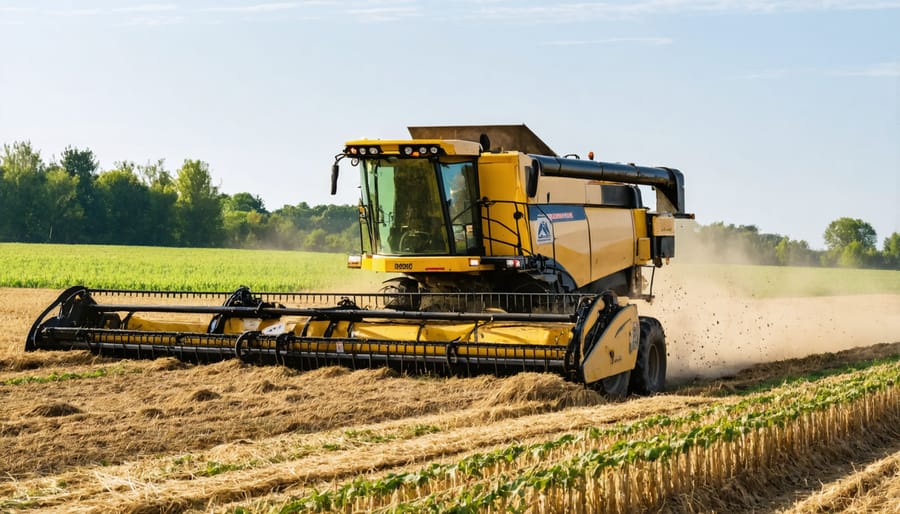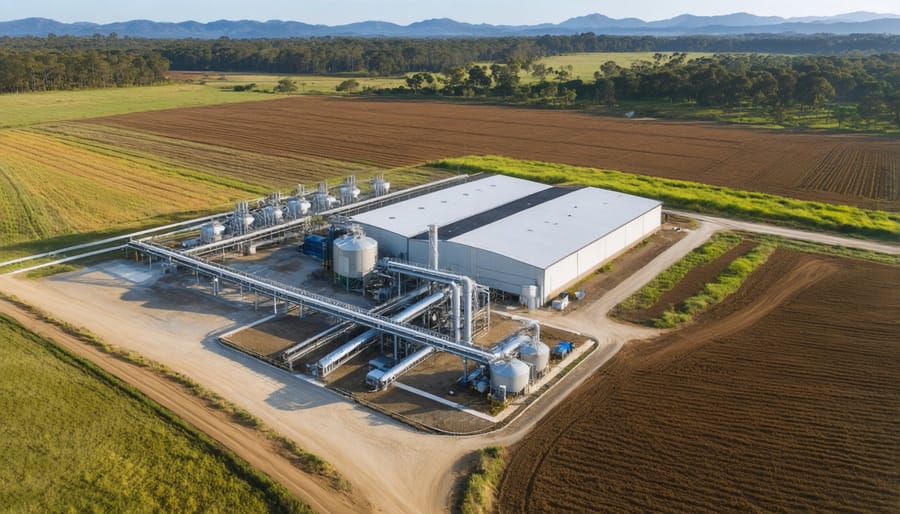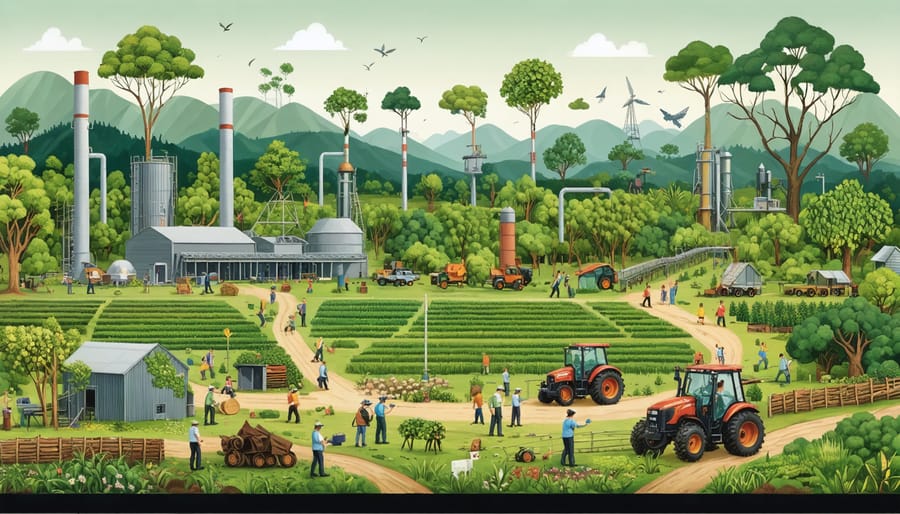Biomass energy is revolutionizing Australia’s rural economy, transforming rural Australian communities through sustainable development and economic growth. From agricultural waste to purpose-grown energy crops, this renewable resource generates over $4 billion annually while creating thousands of local jobs across the supply chain. Unlike traditional energy sources, biomass production keeps wealth circulating within regional communities, supporting farmers, transport operators, and processing facilities while reducing dependence on fossil fuels.
In Queensland alone, the biomass industry has created over 2,500 direct jobs since 2018, with each biomass facility supporting an additional 3-4 indirect positions in supporting services. This ripple effect extends beyond employment, stimulating local businesses, increasing land values, and attracting infrastructure investment. As global demand for renewable energy solutions grows, Australia’s biomass sector stands poised to capitalize on its abundant natural resources and agricultural expertise, offering a blueprint for sustainable economic development that balances environmental stewardship with rural prosperity.
The Rural Employment Revolution
Direct Employment Opportunities
The bioenergy jobs boom is creating diverse employment opportunities across Australia’s regional communities. From farm workers collecting agricultural residues to skilled technicians operating sophisticated processing equipment, the biomass industry is becoming a significant employer in rural areas.
Biomass collection roles typically employ local agricultural workers and contractors who gather crop residues, forestry waste, and dedicated energy crops. These positions often complement existing farming operations, providing additional income streams during off-peak seasons. Transport and logistics personnel are also essential, moving biomass materials from collection points to processing facilities.
Processing facilities require various skilled workers, including plant operators, maintenance technicians, and quality control specialists. These roles often pay above-average wages and provide stable, year-round employment. A typical medium-sized biomass facility employs 20-30 full-time staff members, with larger operations supporting up to 100 direct jobs.
Plant operations create high-skilled positions for engineers, technicians, and facility managers. These roles often attract professionals to regional areas, contributing to community growth and development. Many facilities also employ laboratory technicians to monitor biomass quality and process efficiency.
The beauty of biomass employment lies in its accessibility – while some positions require specialized training, many entry-level roles provide on-the-job training, creating career pathways for local workers. This inclusive approach helps build sustainable regional workforces while supporting Australia’s transition to renewable energy.
Supporting Industries Growth
The growth of biomass energy projects in Australia has triggered a remarkable ripple effect across multiple supporting industries, creating a robust economic ecosystem. Local transport companies have experienced significant growth, with many expanding their fleets to handle the increased demand for biomass material transportation. In regional areas like the Gippsland region, trucking businesses report up to 30% increases in their workforce to manage biomass-related logistics.
Agricultural suppliers have also benefited substantially, with many diversifying their offerings to include specialized equipment for biomass crop harvesting and processing. This adaptation has led to the emergence of new business opportunities, particularly in equipment maintenance and spare parts supply chains.
The flow-on effects extend to professional services, with local accounting firms, environmental consultants, and legal practices expanding their expertise to serve the growing biomass sector. Training providers and technical colleges have developed specialized courses to meet the industry’s skilled workforce demands, creating additional employment opportunities in education and skills development.
Small businesses in rural communities are experiencing increased activity, from local cafes serving project workers to hardware stores supplying maintenance materials. Indigenous-owned enterprises have found new opportunities in land management and biomass collection, contributing to both economic and cultural sustainability.
This interconnected growth demonstrates how biomass projects act as catalysts for broader economic development, creating diverse employment pathways and strengthening regional business communities.

Farm Income Diversification
Crop Residue Value
Agricultural waste, once considered a burden for farmers, is emerging as a valuable resource in Australia’s biomass industry. Crop residues like wheat straw, corn stalks, and sugarcane bagasse are being transformed into profitable energy sources, creating new revenue streams for rural communities.
A typical wheat farm in New South Wales can generate up to 2 tonnes of straw per hectare, which traditionally required costly disposal methods. Now, these residues are being sold to biomass facilities, earning farmers additional income while solving disposal challenges. The Sunshine Coast’s sugarcane industry demonstrates this transformation perfectly, with bagasse powering local sugar mills and excess energy being sold back to the grid.
This shift isn’t just about waste management – it’s creating a circular economy where agricultural by-products drive sustainable energy production. Forward-thinking farmers are incorporating residue collection into their business models, some reporting up to 15% increases in annual revenue through biomass sales.
Local initiatives are also emerging where farmers collaborate to establish collection networks, reducing transport costs and maximizing returns. These community-driven approaches are particularly successful in regions like the Victorian Mallee, where coordinated harvesting and storage systems ensure steady biomass supply throughout the year.

Energy Crop Economics
Energy crops have emerged as a promising agricultural venture for Australian farmers, offering a reliable additional income stream while contributing to renewable energy production. Crops like mallee eucalyptus, sorghum, and switchgrass are particularly well-suited to Australia’s climate and can be grown on marginal land that might otherwise remain underutilised.
The financial returns from energy crops vary depending on factors such as location, soil quality, and market conditions. Typically, farmers can expect returns of $500-1,500 per hectare annually once crops reach maturity, with establishment costs ranging from $2,000-4,000 per hectare. These initial investments are often offset by government incentives and renewable energy certificates.
Success stories from regional areas like the Western Australian wheatbelt showcase how energy crops can complement existing farming operations. For instance, the integration of mallee plantations with conventional agriculture has helped farmers diversify their income while providing environmental benefits such as reducing soil erosion and managing salinity.
Contract farming arrangements with bioenergy facilities provide farmers with guaranteed income streams, reducing market risks. Additionally, the development of energy crop industries creates ancillary business opportunities in harvesting, transportation, and processing, further strengthening rural economies. As demand for renewable energy continues to grow, energy crops represent an increasingly viable long-term investment for Australian agriculture.
Regional Infrastructure Development

Processing Facilities
Investment in biomass processing facilities represents a significant economic driver for rural Australian communities. These facilities, ranging from pellet mills to biorefinery plants, are increasingly becoming focal points for regional development while powering Australia’s renewable future.
Local processing facilities typically require initial investments between $5-50 million, depending on scale and complexity. This capital injection flows through communities in multiple ways, from construction jobs to ongoing operational positions. For instance, the Narrogin biomass facility in Western Australia created over 50 permanent positions and supported an additional 150 indirect jobs in transportation and maintenance sectors.
These facilities serve as economic multipliers, attracting related industries and fostering innovation hubs. When a processing plant establishes in a region, it often sparks the development of supporting businesses, from equipment suppliers to logistics services. The Mount Gambier bio-hub demonstrates this ripple effect, where one facility attracted three affiliated businesses within two years of operation.
Beyond job creation, processing facilities help stabilize rural economies by providing steady income streams for farmers and forest managers who supply raw materials. They also reduce transportation costs for biomass producers by providing local processing options, making the entire supply chain more efficient and profitable for all stakeholders.
Transport Networks
The development of biomass industries has catalyzed significant improvements in rural transportation infrastructure throughout Australia’s regional areas. As biomass facilities require consistent feedstock delivery, local councils and industry partners have invested heavily in upgrading road networks and establishing efficient logistics systems to support these operations.
In the Goulburn Valley region, for example, the establishment of a major biomass processing facility led to the upgrade of over 200 kilometers of rural roads, benefiting not just biomass transporters but also local farmers and residents. These improvements have reduced transportation costs by up to 30% for agricultural businesses in the area.
The ripple effect extends beyond road infrastructure. Rail networks have seen renewed interest, with several regional lines being reopened or upgraded to handle biomass freight. This development has created more cost-effective transport options for rural communities and opened up new market opportunities for local producers.
Modern logistics systems, including GPS tracking and smart scheduling, have been implemented to optimize biomass collection and delivery routes. These innovations have not only improved operational efficiency but also reduced wear and tear on roads and minimized environmental impact through better route planning.
The enhanced transport infrastructure has become a catalyst for broader economic development, attracting new businesses to rural areas and improving connectivity between regional communities and major markets.
Community Economic Benefits
Local Business Growth
The establishment of biomass facilities creates a powerful ripple effect throughout regional economies, fostering local economic growth that extends far beyond direct employment. Local transport companies benefit from increased demand for biomass material transportation, while agricultural suppliers see heightened business activity from farmers diversifying into energy crops. Engineering firms and maintenance services experience steady work maintaining biomass facilities, creating year-round revenue streams.
In rural communities like Narrogin, Western Australia, the presence of biomass operations has revitalized supporting businesses, from local hardware stores to accommodation providers. Cafes and restaurants report increased patronage from facility workers, while technical training providers have expanded their services to meet industry needs. Agricultural contractors have diversified their offerings to include biomass harvesting and processing services, creating additional income streams during traditionally quiet periods.
The multiplier effect is particularly evident in equipment sales and servicing, with local dealerships reporting significant increases in specialized machinery sales and maintenance work. This business ecosystem creates a sustainable cycle of economic activity that strengthens community resilience and promotes long-term regional development.
Tax Revenue and Public Services
Biomass projects in rural Australia have become significant contributors to local government revenue streams through rates, permits, and various licensing fees. In towns like Manjimup, Western Australia, where biomass facilities have been established, councils report substantial increases in their annual tax base, enabling enhanced public services and infrastructure development.
These additional revenue streams have translated into tangible community benefits. Local councils have been able to upgrade roads, improve emergency services, and enhance recreational facilities. For instance, the Mount Gambier region has seen a 15% increase in council revenue since the establishment of its biomass processing facility, leading to the construction of new community centres and expanded library services.
The flow-on effects extend to essential services, with many regional areas experiencing improvements in healthcare facilities and educational resources. Biomass projects often include community benefit agreements, ensuring a portion of profits directly supports local initiatives. In Queensland’s Western Downs region, biomass operations contribute to maintaining rural fire services and funding local school programs, demonstrating how renewable energy projects can strengthen the fabric of rural communities while supporting their transition to sustainable practices.
Energy Cost Savings
Local communities across Australia are discovering significant cost savings by switching to biomass energy solutions. In regions like Gippsland, Victoria, businesses and public facilities have reported energy cost reductions of up to 40% after transitioning to locally-sourced biomass heating systems. These savings are particularly impactful for energy-intensive operations such as hospitals, schools, and agricultural processing facilities.
The cost benefits stem from multiple factors, including the stable pricing of biomass fuels compared to volatile fossil fuel markets. For instance, the Mount Gambier Aquatic Centre saved over $60,000 annually by switching to a wood chip heating system sourced from local timber processing waste. This predictable cost structure allows facilities to better manage their long-term budgets and invest in community development.
Rural communities benefit further through reduced transportation costs, as biomass fuel is typically sourced within a 50-kilometre radius of where it’s used. This local supply chain not only keeps energy dollars circulating within the community but also provides a reliable, drought-resistant income stream for farmers and forestry operators who supply agricultural and woody biomass residues.
When combined with modern efficient burning technologies, these systems offer both immediate and long-term financial advantages while supporting local economic resilience.
As we’ve explored throughout this article, biomass has emerged as a powerful catalyst for rural Australia’s economic transformation. The industry has created thousands of direct jobs in farming, processing, and transportation, while simultaneously fostering growth in supporting sectors like manufacturing and technical services. Communities that once struggled with population decline are now experiencing renewed vitality, with young professionals returning to take advantage of emerging opportunities in the bioeconomy.
The ripple effects of biomass development extend far beyond immediate employment gains. Local businesses are thriving, property values are stabilizing, and regional infrastructure is improving. Most importantly, biomass projects are providing farmers with valuable income diversification options, strengthening the resilience of rural economies against traditional agricultural market fluctuations.
Looking ahead, the future of biomass in rural Australia appears remarkably promising. With increasing global demand for sustainable energy solutions and growing domestic support for renewable technologies, the sector is positioned for substantial growth. Industry experts project that biomass could contribute up to $5 billion annually to rural economies by 2030, while helping Australia meet its emissions reduction targets.
The key to maximizing these benefits lies in continued collaboration between government, industry, and local communities. By maintaining focus on sustainable practices, investing in research and development, and supporting skill development programs, rural Australia can fully capitalize on the transformative potential of biomass, creating a more prosperous and sustainable future for regional communities.

